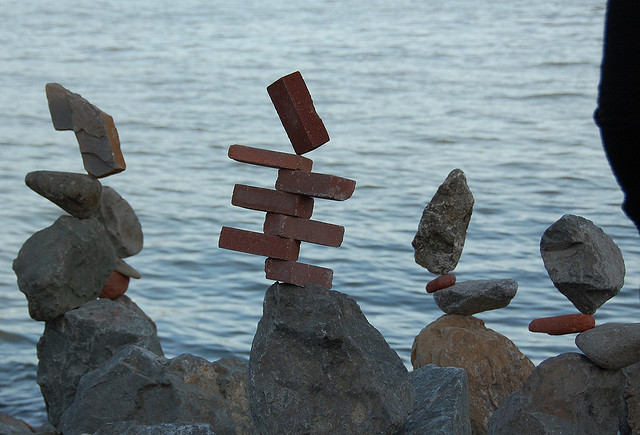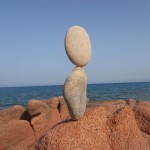 My neighborhood, as I’ve mentioned, is an interesting place: At our weekly potlucks, we speculate on everything from the number and sex of the next batch of goat kids (money’s on two girls) to the efficacy of bourbon as mouthwash (not promising, sadly). Last week, a guest announced that he was on his way to a stone-balancing celebration in Flagstaff, Arizona. Was this a competition, we asked? No. Just a bunch of people stacking stones? Well, yes, but it’s more fun than it sounds. Do you leave the stacks for other people to find? Yup.
My neighborhood, as I’ve mentioned, is an interesting place: At our weekly potlucks, we speculate on everything from the number and sex of the next batch of goat kids (money’s on two girls) to the efficacy of bourbon as mouthwash (not promising, sadly). Last week, a guest announced that he was on his way to a stone-balancing celebration in Flagstaff, Arizona. Was this a competition, we asked? No. Just a bunch of people stacking stones? Well, yes, but it’s more fun than it sounds. Do you leave the stacks for other people to find? Yup.
“Just Google it,” he finally said, giving us a beatific smile.
So I did, and found that yes, a bunch of people gathered in Flagstaff this past Sunday to stack stones. It seems to be habit-forming: this was the third international gathering of stone balancers, and balancers have even written an “Art Manifesto of Stone Balance” with ethical guidelines. (No glue, no bolts, no wires. Just gravity.) For some, such as artists Adrian Gray and Andy Goldsworthy, stone balancing is high art. For others, it’s a meditative practice or just a prankish pastime, a puzzle left on a beach or beside a trail for others to find. Some sculptures resemble people, sailboats, bridges, or birds; others are free-form. Some are “pure balance” sculptures, with each rock balanced in line with its center of gravity. Other sculptures use counterbalance.
Rock balancers seem to have a refreshing resistance to philosophizing: Bill Dan, an Indonesian-born rock balancer in San Francisco, says, “Some people try to make things too complicated. This is the opposite.”
I have to admit, I’m entranced by these sculptures. Their balance is soothing, but their improbability is exciting: When is that thing going to fall over? How close can I get before it does? They make me feel calm and alert, peaceful and vigilant … all sensations I wish I could bottle and take to work with me.
As the next best thing, here are a few photos to enjoy on a Monday morning:
Top photo from Flickr user jayul.
Bottom photos from Flickr users Alex J White, sashapo, ej65, and agnesswart. All licensed under Creative Commons.




The stacks are a monument to impermanence. I love that they’re a practice in patience and non-attachment.
There are many stone stackers here in Vermont. There’s even an offshoot of the practice in which the stackers stack stones on rounded boulders protruding from streams and rivers. Imagine the committment that takes. First you must collect stones. Then wade to a suitable boulder. Then stack, probably losing stones to the river currents in the process, which requires finding more stackable stones. Then, unlike landlocked stacks which, depending on the skill of the stacker, could last a season or two, the river stacks are washed away by the next big storm that swells the river and scrubs the boulders clean.
Very cool, Michelle. Do you think this artform might be inspired in any way by the Inuit Inukshuk?
http://www.inukshukgallery.com/inukshuk.html
Heather, I don’t know, but those are remarkable. Have you seen any firsthand?
I’ve never seen any of the old ones, but when I was on Baffin Island a year ago, our Inuk bear monitor, Donny Pitsiulak, made several around the perimeter of the archaeological camp. Some looked like birds. Donny told me that the elders instructed him to make them there in order to keep the polar bears away. It worked.
I bought a small Inukshuk at a gallery in Montreal, Canada. I love it.
@Anne “landlocked stacks which, … could last a season or two”
I guess there’s a difference between stacking and balancing.
I’ve been balancing stones on a beach near me for a few years and I’m delighted ifthey last a day or two! For me the joy of it is having stones balanced so delicately that it looks impossible. The downside is that even a sudden gust of wind can (and often does) take a tower down…
http://www.rocksontop.net << in progress